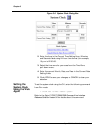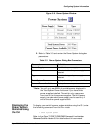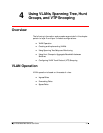
4-2
Chapter 4
Cajun P550/P880/P882 Switch User Guide
Ingress Rules
Every frame received by the switch is classified to one VLAN. There
are two ways in which frames are classified to VLANs:
■ Untagged frames are classified to the VLAN associated with the
port on which the frame is received (Port-based VLANs).
■ Tagged frames are classified to the VLAN identified by the VLAN
tag in the tag header of the frame.
*Note: The switch supports a feature called Automatic
VLAN Creation for tagged frames. When this
feature is enabled, the switch creates new VLANs
when it receives packets from previously unknown
VLANs.
Forwarding Rules
These rules determine the set of ports on the switch through which
members of the VLAN can be reached. This is called binding a port
to a VLAN. A port may be bound to a VLAN using four methods:
■ Setting the Port VLAN attribute in the Switch Port Configuration
dialog box of the port form. This identifies the VLAN to which
all untagged frames received on the port are forwarded.
*Note: Note: A port has one Port VLAN. Changing this to
a new VLAN removes the port from the old VLAN.
■ Setting the VLAN Binding attribute in the Switch Port
Configuration dialog box to Bind to All. This causes the port to
be bound to all VLANs known to the switch (for example, all
current VLANs and all VLANs added in the future).
■ Setting the VLAN Binding attribute in the Switch Port
Configuration dialog box to Bind to Received. This causes the
port to be bound to all VLANs (as identified by the VLAN tag in
tagged frames) received on this port. Consequently, ports are
bound to those VLANs that actually have members that are
reachable through the port.
■ Manually creating a VLAN Switch Port via the CLI.


















